Hiking to see the autumn leaves is popular in Japan, but cherry blossom hikes in spring hold equal allure. Here are 17 cherry blossom hikes spanning the country, offering a chance to immerse in the beauty of cherry blossoms while trekking.
Cherry blossoms have captivated the hearts of the Japanese since ancient times, with their fleeting nature, scattering within a brief span of about two weeks. While city cherry blossoms hold their charm, those in full bloom in the mountains evoke a distinct sensation of the great outdoors.
Compared to autumn leaves, cherry blossoms can be observed in lower mountains, making hiking accessible even to beginners.
One of the best ways to explore Tokyo is to visit the local areas and immerse yourself in the local culture. If you want to explore local areas, we have created scavenger hunt adventures personalised to your interests, filled with fun facts, clues and puzzles. If you’re curious, you can check out the games here! Check out the Flip Japan Games here! |
Find out more about Spring in Japan here: What to do in Spring, Where to go in spring, Wisteria in Japan, Spring date ideas, What to eat in spring, Where to see cherry blossoms in Tokyo, and Cherry blossom festivals.
10 Cherry Blossom Hiking Trails in the Kanto Area
First of all, let’s take a look at the popular cherry blossom spots in the mountains around the Kanto area. All of these are relatively easy to access since they are located close to the city center, making them perfect for cherry blossom hikes.
1. 高尾山 Mount. Takao (Okutama)

Located in Hachioji, Tokyo, Mount Takao stands at an altitude of 599m and ranks among the most climbed mountains worldwide. Cable cars and lifts conveniently connect to its midpoint. The main mountain trail is predominantly paved, making it accessible even in sneakers.
Beautiful cherry blossoms adorn the area around Kiyotaki Station and JR Takao Yamaguchi Station at the mountain’s base, as well as near Icchodaira on the route from the summit to Mount Jinba. Mount Takao attracts thousands of hikers each spring, so if possible, consider visiting on weekdays to escape the crowds.
Best time to see cherry blossoms: Early April
2. 大山 Mount. Oyama (Tanzawa)
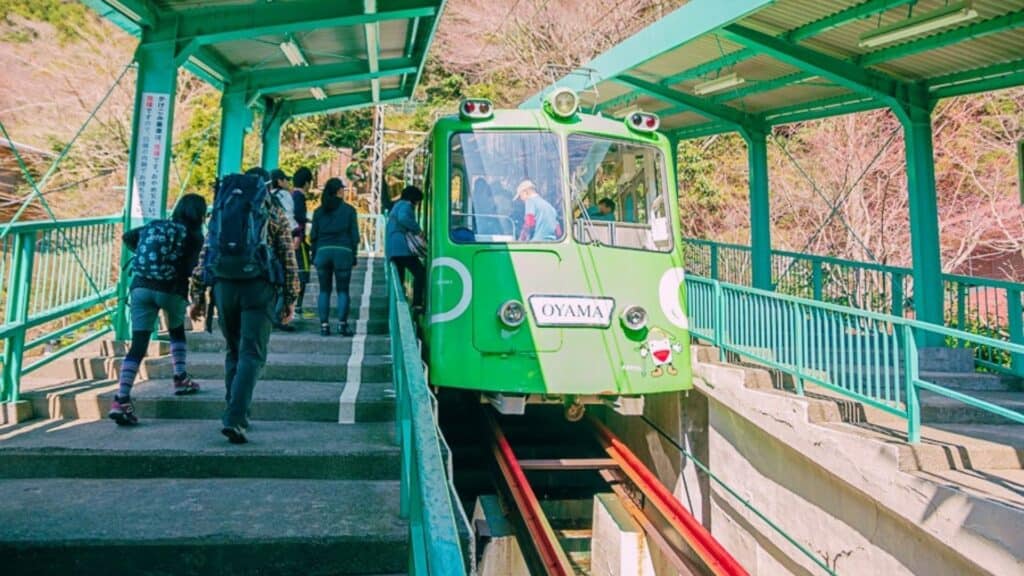
Mount Oyama in the Tanzawa Mountains is a favored destination for families and novice hikers, thanks to its accessibility via cable car to the mountain’s midsection at an altitude of 1,252m.
While Mount Oyama is renowned for its spectacular autumn foliage, its Oyama cherry blossoms, visible at the mountain’s base in spring, also draw significant attention. We suggest exploring the Oyama Sakura Hiking Course, a leisurely one-hour hike. Along the trail, you’ll encounter four magnificent sakura trees, each over 400 years old.
Best time to see cherry blossoms: Early April
3. 六国見山 Koboyama Park (Hadano)
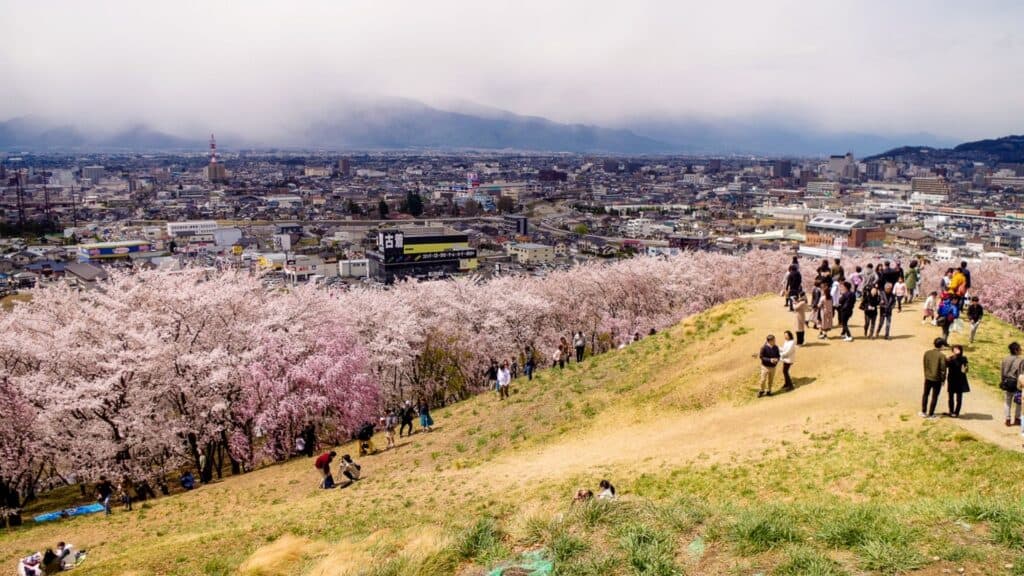
Koboyama Park, a prefectural natural park situated southeast of Mount Tanzawa, showcases a breathtaking sight in spring. Over 2000 cherry blossoms, including Yoshino cherry trees and wild cherry blossoms, paint the park with vibrant hues. The road linking Mt. Gongen and Mt. Kobo transforms into a captivating cherry blossom corridor during this season, earning the park recognition as one of the “100 Famous Flower Spots in Kanagawa.”
In addition to cherry blossoms, Koboyama Park features a variety of flowers like hydrangeas and lilies. At night, the cherry blossom trees are illuminated, imbuing the area with a unique ambiance, perfect for cherry blossom hikes.
Best time to see cherry blossoms: Late March-Early April
4. 妙義山 Mount Myogi (Gunma)
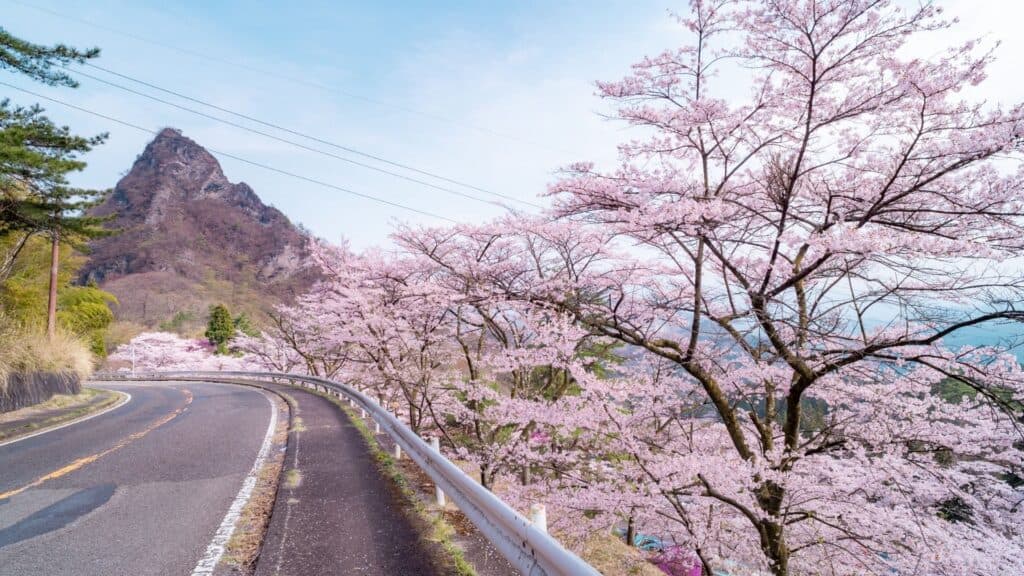
Mount Myogi, well-known for its unique rock formations, features a sprawling 47-hectare park named “Sakura no Sato,” housing 5,000 cherry trees representing 45 species, situated at the southern base of the mountain. These cherry blossoms bloom at varying times, providing an extended period for cherry blossom viewing from mid-April to early May.
The park offers well-maintained sidewalks and rest areas, allowing visitors to enjoy leisurely cherry blossom hikes or pleasant picnics in a tranquil setting.
Best time to see cherry blossoms: Mid-April to early May
5. 筑波山 Mount Tsukuba (Ibaraki)

At 877 meters above sea level, Mount Tsukuba offers easy access via cable car or ropeway, making it an ideal and leisurely destination for individuals of all ages. The Yoshino cherry tree typically reaches full bloom from late March to early April each year, accompanied by the early-blooming Kawazu cherry blossoms and Yae Sakura varieties.
Weeping cherry blossoms grace the surroundings of the cable car’s Miyawaki Station, while cherry blossoms adorn the landscapes near the Tsukubasan Omidou and Tsukubasan Shrines. For a panoramic view of Mount Tsukuba and the cherry blossoms, visitors can enjoy the breathtaking scenery from a distance at Hojo Oike, capturing the entire vista in one glance.
Best time to see cherry blossoms: Late March-Early April
6. 太平山 Mount Ohira (Tochigi)

Mount Ohira, standing at 341 meters in the southern region of Tochigi Prefecture, is a petite yet picturesque mountain offering abundant colors throughout the four seasons, including vibrant hydrangeas and autumn foliage. In spring, it bursts into beauty with cherry blossoms, earning its place as one of Japan’s renowned spots for cherry blossom hikes.
Along the north side leading to the mountaintop, thousands of cherry blossom trees line the sightseeing road, creating a popular cherry blossom tunnel. Additionally, at the base of Taisanji Temple, stands a 350-year-old weeping cherry tree. Illuminated at night, it offers a unique and enchanting sight exclusive to this location.
Best time to see cherry blossoms: Early April to mid-April
7. 武甲山 Mount Buko (Chichibu)

Mount Buko, towering at 1,304 meters, spans across Chichibu City and Yokoze City in Saitama Prefecture. As one of Japan’s renowned 200 mountains, it boasts a distinct pyramid shape, offering picturesque views of limestone mining traces from afar.
From mid-April to May, the foot of Hitsujiyama Park comes alive with over 400,000 moss phlox of nine species in full bloom, painting one side of the mountain in stunning pink hues. This spectacle is truly captivating. Additionally, during this season, visitors can partake in various events hosted in the special market of Chichibu Road and in the city, enhancing the cherry blossom hikes experience.
Best time to see cherry blossoms: Mid-April to early May
8. 宝登山 Hodosan (Chichibu)

Hodosan, rising 497 meters in Chichibu, Saitama Prefecture, is renowned as “Sakura, Ume and Hodosan,” one of the eight renowned views of Nagatoro. The area is celebrated for its diverse cherry blossoms, with the season typically commencing around the end of March in Nagatoro.
Along the Arakawa River from Nagatoro Station, Somei Yoshino cherry blossoms bloom, accompanied by over 500 double cherry blossoms of approximately 30 species at the mountain’s base. The cherry blossom trees lining the approach to the mountain shrine are recognized as one of the “100 Best Cherry Blossom Spots in Japan.” Additionally, during the season, the area is illuminated at night, enhancing the cherry blossom hikes experience.
Best time to see cherry blossoms: Late March-Early April
9. 棒ノ嶺 Bonooreyama (Oku Musashi)

Bonooreyama is a mountain standing at an altitude of 969 meters, situated on the border between Okutama Town and Hanno City in Saitama Prefecture. Embarking on a hike up to the mountaintop offers a breathtaking view, surrounded by cherry blossoms in full bloom. It’s an ideal location for cherry blossom hikes and picnics, allowing visitors to relish the panoramic scenery of the surrounding mountains and cherry blossoms.
Best time to see cherry blossoms: Mid-April to late April
Cherry Blossom Hiking Trails in Tokai and Hokuriku
Next, let’s explore some popular locations slightly further from the Kanto area! Among them are Mount Hanami in Fukushima and Mount Amagi in Izu.
10. 花見山 Hanamiyama (Fukushima)

Hanamiyama is a well-known flower spot located in Watari, Fukushima. During springtime, a variety of cherry blossoms, including Tokai-zakura, Higanzakura, and Yoshino cherry trees, along with flowering trees like plum blossoms and Japanese allspice, bloom simultaneously.
Hanamiyama originated from efforts by local farmers involved in flower and tree cultivation who cleared and planted thickets. It was opened to the public in 1959 and has since evolved into a prominent cherry blossom hikes viewing spot attracting numerous visitors each year.
Best time to see cherry blossoms: Early April to late April
11. 天城山 Mount Amagi (Izu)

Mount Amagi is a mountain range composed of 1,000-meter peaks such as Mt. Mansaburo, Mt. Manjiro, and Mt. Tokasa, and is among the 100 famous mountains in Japan. Covered with virgin forests including beech and rhododendron, Mount Amagi is renowned for its stunning seasons of fresh greenery and autumn foliage.
During spring, the mountain trail offers views of Mount Mamezakura and Japanese andromeda in full bloom, along with cherry blossoms adorning the summit of Mt. Mansaburo.
Best time to see cherry blossoms: Early April to early May
Cherry Blossom Hiking Trails in Chubu
Here are three must-visit cherry blossom spots in the Shinshu area.
12. 光城山Mount Hikarujo (Azumino)

Mount Hikarujo, standing at an altitude of 911.7 meters, is situated in Azumino, Nagano Prefecture. Along the mountain trail, 1500 to 2000 Yoshino cherry trees are planted. From the mountain’s summit, you can enjoy panoramic views of Azumino, with the majestic peaks of the Northern Alps, including Mount Jonen and Mount Yari, in the background. During late April, when the cherry blossoms are in full bloom, the area is illuminated at night, allowing visitors to delight in cherry blossom hikes even after dark.
Best time to see cherry blossoms: Mid-April to late April
13. 岩殿山 Mount Iwatono (Otsuki)

Located in Otsuki City, Yamanashi Prefecture, Mount Iwatono stands at 634 meters high, the same height as the Sky Tree, and is characterized by its exposed rock surface. It is a renowned low mountain, selected as one of the 100 famous mountains of Yamanashi and as part of the 12 views of Shurei Tomitake. Maruyama Park, situated at the southern foot of the mountain, boasts over 300 cherry trees in full bloom, offering views of Yoshino cherry trees from the end of March and Yae Sakura from the end of April. From Maruyama Park, you can also enjoy the breathtaking sight of Mount Fuji, combining the beauty of cherry blossoms and the iconic mountain together.
Best time to see cherry blossoms: Late March-Early April
14. 弘法山古墳 Koboyama Tomb (Matsumoto)
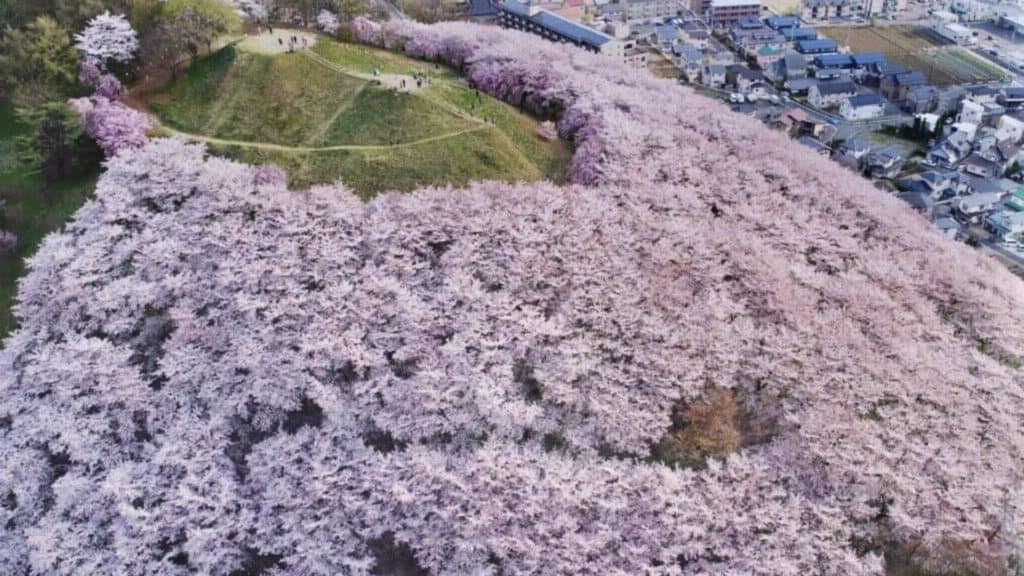
Koboyama Tomb, the oldest tumulus in eastern Japan, is situated in the southeastern part of Matsumoto City, Nagano Prefecture. Believed to have been constructed at the end of the 3rd century, this tomb holds historical significance.
During springtime, at an altitude of 650 meters on the summit of Mt. Kobo, thousands of cherry blossoms, including Oyamazakura and Kohiganzakura varieties, paint the landscape pink. The site is immensely popular, attracting numerous cherry blossom viewing visitors, and hosts the “Koboyama Kobo Sakura Festival” from early to late April. Additionally, the area is illuminated at night, offering visitors the opportunity to appreciate the scenery even after dark.
Best time to see cherry blossoms: Early April to mid-April
Cherry Blossom Hiking Trails in Western Japan
Introducing well-known places in the western Japan area west of Kansai! Due to its warmer climate, the flowering time here is relatively early.
15. 高御位山 Mount Takamikura (Hyogo)

Mount Takamikura, positioned on the border between Kakogawa City and Takasago City in Hyogo Prefecture, boasts an altitude of approximately 304 meters. This area is also affectionately known as “Harima Fuji” and is a popular destination for witnessing the first sunrise of the year.
From the summit, visitors can enjoy panoramic views of the Harima Plain and the Seto Inland Sea. At the mountain’s base lies Kashima Ogidaira Nature Park, where 2000 cherry blossoms bloom in the spring. The park features an observatory and a hiking course, along with Kashima Shrine adjacent to it.
Best time to see cherry blossoms: Late March-Early April
16. 野呂山 Mount Noro (Hiroshima)

Mount Noro covers a plateau region with an altitude of approximately 800 meters, spanning between Mt. Noro and Mt. Koboji in Kure City, Hiroshima Prefecture. This area offers a plethora of attractions and activities for visitors to enjoy.
During springtime, the Sazanami Skyline leading to Mount Noro becomes adorned with 1500 cherry blossom trees in full bloom, offering a picturesque sight against the backdrop of the Seto Inland Sea.
Best time to see cherry blossoms: Early April
17. 市房山 Mount Ichifusa (Kumamoto)
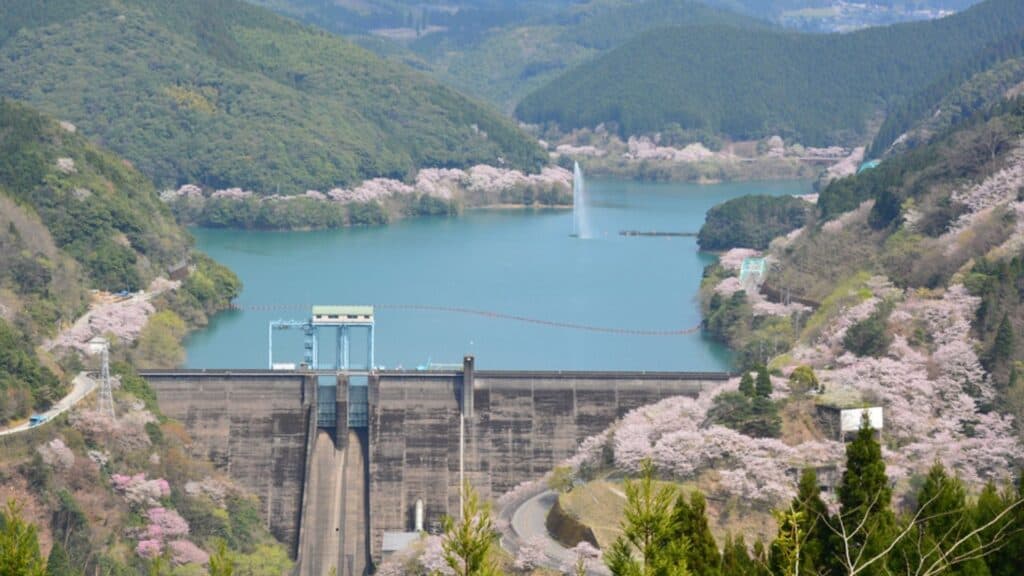
Mount Ichifusa, located on the prefectural border between Kumamoto and Miyazaki, is a stunning mountain standing at an altitude of 1,720.8 meters. It has been cherished by locals as a sacred mountain in Kumamoto for generations.
At the foot of the Kumamoto side lies Ichifusa Shrine, where the “Odake visit” takes place annually on March 15th of the lunar calendar. In the village further west of Ichifusa Shrine, you’ll find Ichifusa Dam Lake, surrounded by 10,000 cherry trees spanning over 14 kilometers around the dam. This area has become renowned for its cherry blossoms. Events like the Yuyama Onsen Sakura Festival are held in the middle of March, adding to the area’s charm.
Best time to see cherry blossoms: Mid-March to early April
In this blog post, we’ve highlighted renowned cherry blossom hiking spots and mountains suitable for beginners. With numerous hiking trails offering picturesque cherry blossom views, these 17 locations stand out as some of the finest and most popular hikes.
Why not make the most of this year’s cherry blossom season by combining it with hiking? Additionally, many of these places offer more than just hiking experiences. If time allows, be sure to explore the various attractions and activities available in the area.
Find out more about Spring in Japan here: What to do in Spring, Where to go in spring, Wisteria in Japan, Spring date ideas, What to eat in spring, Where to see cherry blossom in Tokyo, and Cherry blossom festivals.
Stay tuned for more information about Japan travel, Japanese culture, moving to Japan, living in Japan, Japanese language, and more.

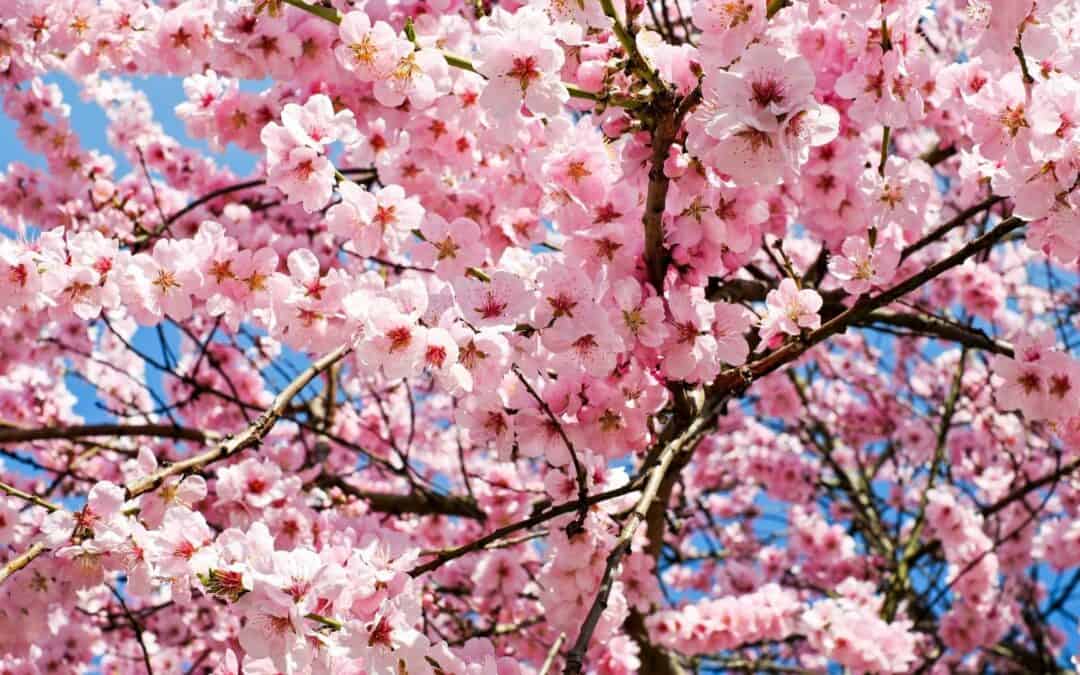
Recent Comments